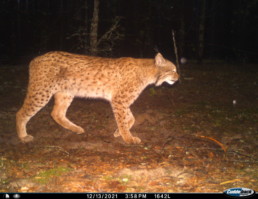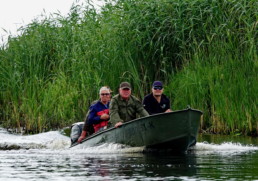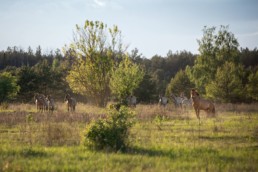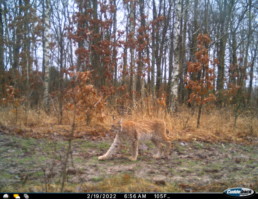The sound of the wilderness
A pilot project in Polesia captures part of the biodiversity using audio recordings. This is a promising new tool for biodiversity monitoring.
Those carrying out biodiversity surveys in Polesia must not be squeamish. It is a wilderness area of superlatives: half the size of Germany, the predominantly peatland landscape stretches from Poland through Ukraine and Belarus into Russia. Rivers in their natural state, overflowing their banks in spring, meander through a mosaic of alluvial forests, bogs, oxbow lakes, floodplain meadows and mires.
Such large contiguous habitats have largely given way to agriculture in other parts of Europe. And these wet and boggy habitats are difficult to traverse. While our colleagues wade slowly across the mires to count rare birds of prey such as the Greater Spotted Eagle or set up camera traps to study wolves and lynx, swarms of mosquitoes and other insects are their faithful companions.
One of the main goals of our work in Polesia is to identify areas that are worth protecting. A better understanding of where there are gaps in protection and where priority areas lie will help us to support and justify requests to expand existing protected areas and designate new ones. Biodiversity and the presence of strictly protected species are among the key criteria.
However, population surveys are usually time-consuming. Additionally, nocturnal animals, such as insects or bats, which are difficult to find, are often overlooked, even though they usually have a high conservation status. Studying smaller animals such as bats, rodents and insects using conventional methods takes a lot of time, effort, patience and financial resources. Therefore, in Polesia we have turned to a new promising instrument for biodiversity research: acoustic monitoring. Bats and other species can now be identified using sound recordings.
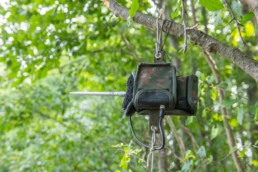
Two years of passive acoustic monitoring
In the largest systematic survey of species diversity in Ukrainian and Belarusian Polesia to date, we carried out what is known as passive acoustic monitoring for two years. We recorded bats, birds, small mammals, bush crickets and some large mammals over an area of about 50,000 square kilometres, comparable in size to Slovakia. In this area, the recording devices were set up at 500 sites for four nights at a time. Thousands of hours of animal sounds have been recorded – day and night, in dense forests and extensive bogs and in every direction within a hundred metres of the recorder.
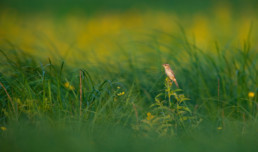
Shazam for animal sounds
The current result is around three million recordings with around 500,000 animal sounds. It would take years to filter out these animal sounds from other environmental noise and identify them individually. Therefore, our project partners at the British Trust for Ornithology have developed an automatic sound classifier. Similar to the mobile phone app Shazam, which can identify pieces of music based on a melody fragment, the new sound classifier is able to match recordings of animal sounds to certain species. The algorithm analyses the spectrogram, i.e. the visual sound image of the recording. It then searches for typical patterns according to known parameters and provides information about the type of sound recorded.
In this way, we can now automatically classify over 50 species of bats, birds, bush crickets and small mammals. To be on the safe side, these are then manually checked and the algorithm is improved where necessary. This allows us to record many species simultaneously, from the Great Grey Owl (Strix nebulosa) and the Pygmy Shrew (Sorex minutus) to bush crickets such as the Great Green Bush Cricket (Tettigonia viridissima).
This method of recording and monitoring the species is non-invasive as the animals are not disturbed compared to traditional methods. Bats, birds and insects do not have to be caught with nets and then examined and identified manually. In addition, acoustic monitoring is cost-effective as it allows the recording of different groups of animals simultaneously, and large amounts of data can be collected in a relatively short period compared to conventional recording methods.
The main objectives of the acoustic monitoring are to systematically map biodiversity throughout Polesia, identify habitats of particular importantance to different species, identify priority conservation areas and assess the impact of human activities such as drainage, fires and road construction on the biodiversity. The species lists also serve as a basis for formal applications to extend protected areas.


